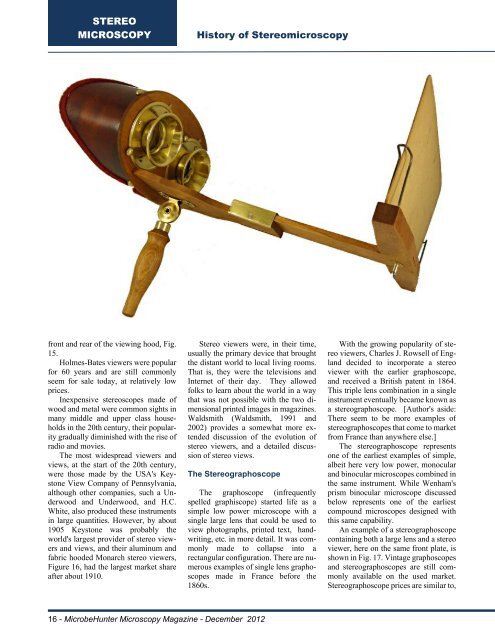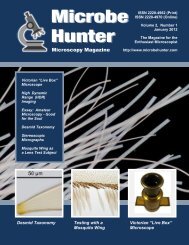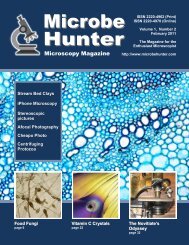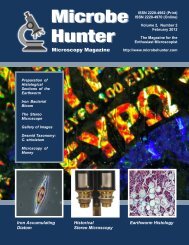December 2012 - MicrobeHunter.com
December 2012 - MicrobeHunter.com
December 2012 - MicrobeHunter.com
Create successful ePaper yourself
Turn your PDF publications into a flip-book with our unique Google optimized e-Paper software.
STEREOMICROSCOPYHistory of Stereomicroscopyfront and rear of the viewing hood, Fig.15.Holmes-Bates viewers were popularfor 60 years and are still <strong>com</strong>monlyseem for sale today, at relatively lowprices.Inexpensive stereoscopes made ofwood and metal were <strong>com</strong>mon sights inmany middle and upper class householdsin the 20th century, their popularitygradually diminished with the rise ofradio and movies.The most widespread viewers andviews, at the start of the 20th century,were those made by the USA's KeystoneView Company of Pennsylvania,although other <strong>com</strong>panies, such a Underwoodand Underwood, and H.C.White, also produced these instrumentsin large quantities. However, by about1905 Keystone was probably theworld's largest provider of stereo viewersand views, and their aluminum andfabric hooded Monarch stereo viewers,Figure 16, had the largest market shareafter about 1910.Stereo viewers were, in their time,usually the primary device that broughtthe distant world to local living rooms.That is, they were the televisions andInternet of their day. They allowedfolks to learn about the world in a waythat was not possible with the two dimensionalprinted images in magazines.Waldsmith (Waldsmith, 1991 and2002) provides a somewhat more extendeddiscussion of the evolution ofstereo viewers, and a detailed discussionof stereo views.The StereographoscopeThe graphoscope (infrequentlyspelled graphiscope) started life as asimple low power microscope with asingle large lens that could be used toview photographs, printed text, handwriting,etc. in more detail. It was <strong>com</strong>monlymade to collapse into arectangular configuration. There are numerousexamples of single lens graphoscopesmade in France before the1860s.With the growing popularity of stereoviewers, Charles J. Rowsell of Englanddecided to incorporate a stereoviewer with the earlier graphoscope,and received a British patent in 1864.This triple lens <strong>com</strong>bination in a singleinstrument eventually became known asa stereographoscope. [Author's aside:There seem to be more examples ofstereographoscopes that <strong>com</strong>e to marketfrom France than anywhere else.]The stereographoscope representsone of the earliest examples of simple,albeit here very low power, monocularand binocular microscopes <strong>com</strong>bined inthe same instrument. While Wenham'sprism binocular microscope discussedbelow represents one of the earliest<strong>com</strong>pound microscopes designed withthis same capability.An example of a stereographoscopecontaining both a large lens and a stereoviewer, here on the same front plate, isshown in Fig. 17. Vintage graphoscopesand stereographoscopes are still <strong>com</strong>monlyavailable on the used market.Stereographoscope prices are similar to,16 - <strong>MicrobeHunter</strong> Microscopy Magazine - <strong>December</strong> <strong>2012</strong>










